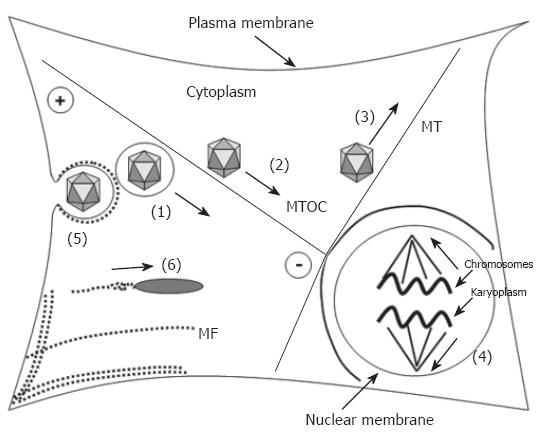Copyright
©2007 Baishideng Publishing Group Co.
World J Gastroenterol. Jan 7, 2007; 13(1): 39-47
Published online Jan 7, 2007. doi: 10.3748/wjg.v13.i1.39
Published online Jan 7, 2007. doi: 10.3748/wjg.v13.i1.39
Figure 1 Participation of microtubules and microfilaments in transport processes.
Transport processes are indicated as bold arrows. Microtubules (MT, bold lines) have a highly dynamic plus-end and a less dynamic minus-end that is located at the microtubule-organizing (MTOC). They participate in the transport of (1) organelles, e.g. endosomes, (2) direct retrograde transport of capsids via the dynein motor protein complex (adenovirus, HSV 1, parvoviruses), (3) direct anterograde transport of progeny HSV 1 capsids by conventional kinesin, and (4) participate in chromosome segregation upon mitosis. Microfilaments (MF), depicted as dotted lines participate (5) in separation of endocytotic vesicles from the plasma membrane and (6) via polymerization in transport of e.g. Listeria monocytogenes and nuclear polyhedrosis virus (NPV).
- Citation: Kann M, Schmitz A, Rabe B. Intracellular transport of hepatitis B virus. World J Gastroenterol 2007; 13(1): 39-47
- URL: https://www.wjgnet.com/1007-9327/full/v13/i1/39.htm
- DOI: https://dx.doi.org/10.3748/wjg.v13.i1.39









